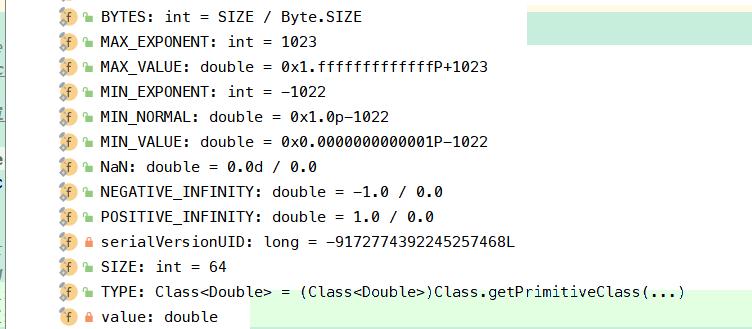09、JDK 源码:Double、Float
一、概述
这个千篇一律,Double是对基本数据类型double的包装,里面包含了double类型的字段。这个类也提供了一些将String和double转换为Double的方法,还有一些处理double的方法。
作者是:
* @author Lee Boynton
* @author Arthur van Hoff
* @author Joseph D. Darcy
* @since JDK1.0
二、属性
提供了很多属性值,如下:

正无穷:POSITIVE_INFINITY:Double.longBitsToDouble(0x7ff0000000000000L)
负无穷:NEGATIVE_INFINITY:Double.longBitsToDouble(0xfff0000000000000L)
非数字:Not-a-Number (NaN):Double.longBitsToDouble(0x7ff8000000000000L)
最大值:MAX_VALUE:Double.longBitsToDouble(0x7fefffffffffffffL)
单精度最小值:MIN_NORMAL:Double.longBitsToDouble(0x0010000000000000L)
双精度最小值:MIN_VALUE:Double.longBitsToDouble(0x1L)
最大指数:MAX_EXPONENT:1023
最小指数:MIN_EXPONENT:-1022
三、主要方法
toString:很简单
toHexString:将double转换为16进制字符串,就是StringBuilder的字符串拼接:
public static String toHexString(double d) {
if (!isFinite(d) )
//如果是NaN或是无穷,直接返回对应的字符串形式
return Double.toString(d);
else {
//初始化最大长度:24
StringBuilder answer = new StringBuilder(24);
if (Math.copySign(1.0, d) == -1.0) // value is negative,
answer.append("-"); // so append sign info
answer.append("0x");
d = Math.abs(d);
if(d == 0.0) {
answer.append("0.0p0");
} else {
boolean subnormal = (d < DoubleConsts.MIN_NORMAL);
// Isolate significand bits and OR in a high-order bit
// so that the string representation has a known
// length.
long signifBits = (Double.doubleToLongBits(d)
& DoubleConsts.SIGNIF_BIT_MASK) |
0x1000000000000000L;
// Subnormal values have a 0 implicit bit; normal
// values have a 1 implicit bit.
answer.append(subnormal ? "0." : "1.");
// Isolate the low-order 13 digits of the hex
// representation. If all the digits are zero,
// replace with a single 0; otherwise, remove all
// trailing zeros.
String signif = Long.toHexString(signifBits).substring(3,16);
answer.append(signif.equals("0000000000000") ? // 13 zeros
"0":
signif.replaceFirst("0{1,12}$", ""));
answer.append('p');
// If the value is subnormal, use the E_min exponent
// value for double; otherwise, extract and report d's
// exponent (the representation of a subnormal uses
// E_min -1).
answer.append(subnormal ?
DoubleConsts.MIN_EXPONENT:
Math.getExponent(d));
}
return answer.toString();
}
}
判断是否为NaN
public static boolean isNaN(double v) {
return (v != v);
}
判断是否无限
public static boolean isInfinite(double v) {
return (v == POSITIVE_INFINITY) || (v == NEGATIVE_INFINITY);
}
判断是否有限
public static boolean isFinite(double d) {
return Math.abs(d) <= DoubleConsts.MAX_VALUE;
}
haseCode被重写了
public static int hashCode(double value) {
long bits = doubleToLongBits(value);
return (int)(bits ^ (bits >>> 32));
}
doubleToLongBits:很多方法中用到了这个方法,理解为将double转换为64位的long即可
- 根据IEEE 754浮点“双格式”位布局返回指定浮点值的表示。
- 位63(由掩码0x8000000000000000L选择的位)表示浮点数的符号。 位62-52(由掩码0x7ff0000000000000L选择的位)表示指数。 位51-0(由掩码0x000fffffffffffffL选择的位)表示浮点数的有效数(有时称为尾数)。
- 如果参数为无穷大,则结果为0x7ff0000000000000L 。
- 如果参数为负无穷大,则结果为0xfff0000000000000L 。
- 如果参数是NaN,结果是0x7ff8000000000000L 。
- 在所有情况下,结果是long整数,当给予longBitsToDouble(long)方法时,将产生与doubleToLongBits的参数相同的浮点值(除了所有NaN值都被折叠为单个“规范”NaN值)。
public static long doubleToLongBits(double value) {
long result = doubleToRawLongBits(value);
// Check for NaN based on values of bit fields, maximum
// exponent and nonzero significand.
if ( ((result & DoubleConsts.EXP_BIT_MASK) ==
DoubleConsts.EXP_BIT_MASK) &&
(result & DoubleConsts.SIGNIF_BIT_MASK) != 0L)
result = 0x7ff8000000000000L;
return result;
}
doubleToRawLongBits:与doubleToLongBits方法不同, doubleToRawLongBits不会将编码NaN的所有位模式折叠到单个“规范”NaN值。是一个native的方法了。
public static native long doubleToRawLongBits(double value);
compare:重写比较,注意Double.NaN返回是0
public static int compare(double d1, double d2) {
if (d1 < d2)
return -1; // Neither val is NaN, thisVal is smaller
if (d1 > d2)
return 1; // Neither val is NaN, thisVal is larger
// Cannot use doubleToRawLongBits because of possibility of NaNs.
long thisBits = Double.doubleToLongBits(d1);
long anotherBits = Double.doubleToLongBits(d2);
return (thisBits == anotherBits ? 0 : // Values are equal
(thisBits < anotherBits ? -1 : // (-0.0, 0.0) or (!NaN, NaN)
1)); // (0.0, -0.0) or (NaN, !NaN)
}
还有三个运算方法
sum,max,min
三、Float
Float与Double非常类似,不再单独讲解